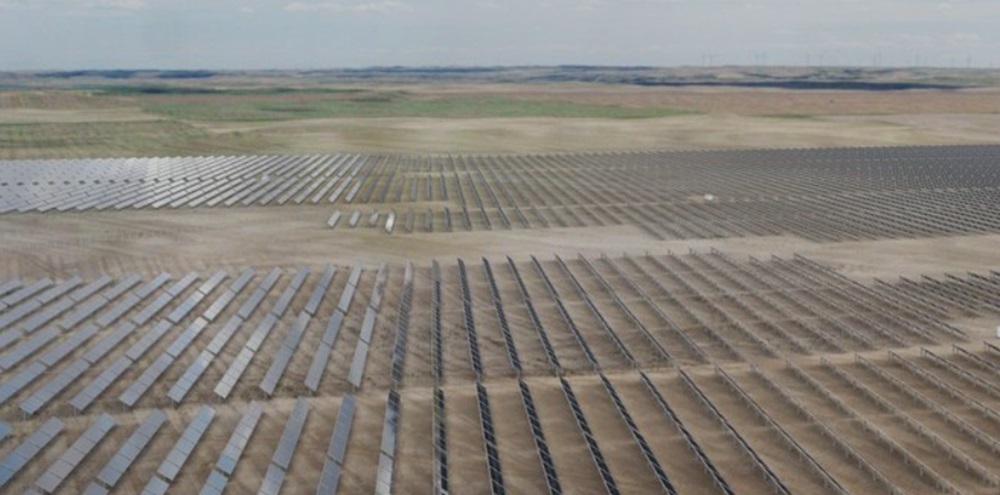From pv magazine global
On Aug. 25, 2023 the Government of Alberta in Canada announced it had directed the Alberta Utilities Commission (AUC) to “pause” approvals on renewable energy projects until the following February, the Minister of Affordability and Utilities Nathan Neudorf said in a statement at the time.
According to a government factsheet, the pause would allow the AUC to conduct an inquiry into policy issues as well as future renewable deployment, with 13 projects – comprising 4.6 MW – suspended. Along with potential policy reform, the inquiry’s scope covers exploring renewable energy’s impact on “Alberta’s pristine view spaces” and “electricity system reliability.”
Alberta is one of the country’s most solar-rich regions and clocked in over 1.1 GW of PV installed capacity in 2022, according to the AUC.
Yves Poissant, renewables research manager at Natural Resources Canada’s CanmetENERGY, told pv magazine that the moratorium has impacted developers. And although they are still at the table, he said they are “impatient to get the projects off the ground.”
“They [the government] wanted to look at what would be the best practices in order to evaluate the regulations regarding solar PV on farmlands, and also sort of the grid integration of variable renewables on the grid.
“We’re looking at this, and hopefully, we’ll find a more appropriate approach to approve these projects and that they are more organized, because most of the growth right now, most of the installed capacity, is in Alberta.”
Poissant said years ago the state shifted away from oil and gas – another abundant local natural resource – and shut down its fossil-fuel generation capacity to usher in “clean energy”. This is why the pause in Alberta, a renewable energy pioneer, has impacted the whole country. “That’s where most of the growth in solar in Canada comes from currently. In Alberta,” Poissant said.
Canadian Renewable Energy Association (CanREA) CEO Vittoria Bellissimo said in August the moratorium was a “mistake” that would impact ratepayers, investors and municipalities.
The comments follow the Paris-based International Energy Agency releasing its survey report of Canadian PV applications in 2022. According to the report, which Poissant co-authored, Canada’s cumulative national installed solar capacity from that year was 4.32 GW – a 12% growth from the year before. Ontario saw the most installations with 2.7 GW, followed by Alberta with 1.3 GW and Saskatchewan with 73 MW.
“To be honest, when I look at the international statistics I have a hard time finding some exciting things to say about Canada. Canada is a very small market,” Poissant said, adding that 2022 was, “not a very special year.”
“There are more than 70,327 PV systems grid-connected in Canada currently. It’s a relatively slow growth but we do see a transition happening.”
Things that helped development, according to the report, include technology advancements being made mainstream, such as the sale of 117,994 electric vehicles. Competitive module prices also helped, with the average price for a standard module crystalline silicon module last year being CAD $0.63 kWh ($0.47) – a jump from the 2021 $0.46 kWh price. The average cost for household electricity was $16.26 kWh with the highest price recorded as $20.98 kWh.
According to the Government of Canada’s sustainable development goals, renewables and non-emitting resources must generate 90% to 100% of electricity by 2030 with coal-fired electricity completely phased out by 2035. “Where we are now?” Poissant asks.
“Most of our electricity in Canada, 60%, is produced by hydroelectricity, which is non-emitting, we have another 15% that’s produced by nuclear, so some provinces like Ontario, and there’s also another nuclear plant in New Brunswick, but mainly Ontario.”
The authors state in the report that solar and wind comprise most of the added electricity generation, with falling prices and capital costs, climate change mitigation policies, and increasing consumer demand making PV one of the most attractive renewable energy options on the market.
“However, PV installations remain variable across the provinces and territories based on their current energy mix and climate change mitigation plan,” according to the report.
This content is protected by copyright and may not be reused. If you want to cooperate with us and would like to reuse some of our content, please contact: editors@pv-magazine.com.








By submitting this form you agree to pv magazine using your data for the purposes of publishing your comment.
Your personal data will only be disclosed or otherwise transmitted to third parties for the purposes of spam filtering or if this is necessary for technical maintenance of the website. Any other transfer to third parties will not take place unless this is justified on the basis of applicable data protection regulations or if pv magazine is legally obliged to do so.
You may revoke this consent at any time with effect for the future, in which case your personal data will be deleted immediately. Otherwise, your data will be deleted if pv magazine has processed your request or the purpose of data storage is fulfilled.
Further information on data privacy can be found in our Data Protection Policy.